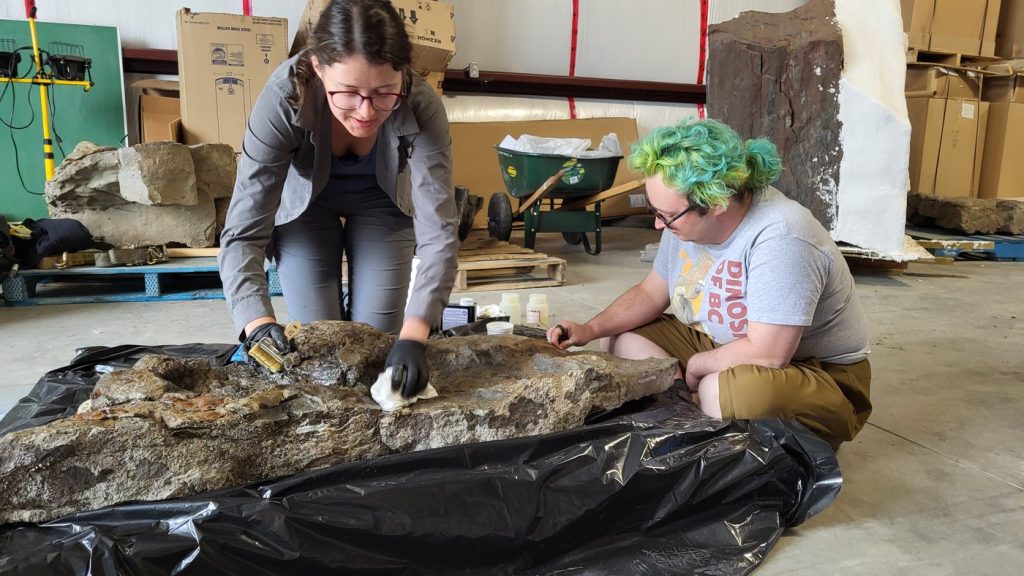Recent research reveals that armoured dinosaurs with clubbed tails once traversed northeastern British Columbia, leaving behind three-toed footprints during a time when the Rocky Mountains were still forming. The study, published in the peer-reviewed Journal of Vertebrate Paleontology, focused on fossilized tracks dating back approximately 100 million years in the Tumbler Ridge region, situated northeast of Prince George, British Columbia, and extending into northwestern Alberta.
Researchers concluded that the footprints belonged to a new species of ankylosaurid ankylosaurs, characterized by their distinct clubbed tails and three toes on their hind feet. Victoria Arbour, a researcher and curator of paleontology at the Royal BC Museum, noted, “It’s actually the first time we’ve identified them anywhere.” While there were previous indications that the footprints were from ankylosaurs, the specific type had remained ambiguous until this study clarified their identity.
The team has named this new species Ruopodosaurus clava, which translates to “the tumbled-down lizard with a club (or) mace.” This discovery underscores that the presence of ankylosaurid ankylosaurs is not limited to the Tumbler Ridge area, suggesting that similar fossils may be found globally. Arbour mentioned, “That’s often what happens is things click into place off one set of fossils, and then other people run with that,” encouraging further exploration of similar footprints nationwide.
Arbour elaborated on the distinct features of ankylosaurid ankylosaurs, contrasting them with nodosaurids, another well-known ankylosaur type that possessed a flexible tail and four hind toes. While nodosaurid footprints, termed tetrapodosaurus, have been plentiful in British Columbia, three-toed footprints had been elusive over the last two decades, creating a mystery regarding which dinosaur was responsible for them. Some of these foot impressions were even discovered by local residents during hikes, demonstrating community involvement in paleontological endeavors.
The collaboration was initiated by Charles Helm, the scientific adviser at the Tumbler Ridge Museum, who invited Arbour to assist in interpreting several three-toed footprints. Utilizing skeletons of other tail-clubbed ankylosaurs, the research team was able to establish a connection and draw significant conclusions about the tracks. The estimated size of the footprints, measuring about 30 centimeters in length, indicates that the animal would have been around five to six meters long.
Describing the morphology of ankylosaurs, Arbour stated, “Ankylosaurs as a group are very sort of short, fat dinosaurs.” They feature short legs, wide bodies, and a unique array of bony plates and spikes for protection against predators. Previous studies have also suggested that these dinosaurs might have used their clubbed tails in territorial disputes or competitions for food and mates.
Despite the acknowledgment of ankylosaurs in the region, there has been a lack of documented evidence in North America from the same period as the footprints. The new research not only confirms their existence but also opens doors for further investigation. Arbour noted, “They’re definitely here, we just aren’t finding their skeletons for some reason,” prompting scientists to seek potential locations for future fossil discoveries.
In a statement from the Royal BC Museum, Helm highlighted the historical significance of ankylosaurs in Tumbler Ridge, recalling that the community’s fascination began 25 years ago with the discovery of an ankylosaur trackway. He expressed excitement over the newly identified species, noting the region’s significance as a habitat for multiple ankylosaur types.
The research indicates that during the time of the ankylosaurs, the Tumbler Ridge area was primarily composed of extensive coastal floodplains and was home to a rich biodiversity, which included small- and medium-sized carnivorous dinosaurs as well as relatives of duck-billed dinosaurs. Additionally, previous studies have indicated the presence of massive crocodilian species, enriching the ecological landscape of the time.










